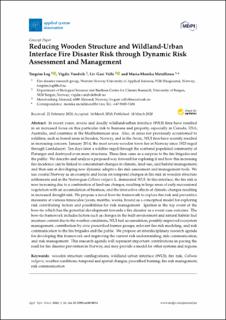| dc.contributor.author | Log, Torgrim | |
| dc.contributor.author | Vandvik, Vigdis | |
| dc.contributor.author | Velle, Liv Guri | |
| dc.contributor.author | Log, Maria-Monika Metallinou | |
| dc.date.accessioned | 2020-12-07T08:58:09Z | |
| dc.date.available | 2020-12-07T08:58:09Z | |
| dc.date.created | 2020-06-27T17:32:34Z | |
| dc.date.issued | 2020 | |
| dc.identifier.citation | Log, T., Vandvik, V., Velle, L. G., & Metallinou, M.-M. (2020). Reducing wooden structure and wildland-urban interface fire disaster risk through dynamic risk assessment and management. Applied System Innovation, 3(1). | en_US |
| dc.identifier.issn | 2571-5577 | |
| dc.identifier.uri | https://hdl.handle.net/11250/2712095 | |
| dc.description.abstract | In recent years, severe and deadly wildland-urban interface (WUI) fires have resulted in an increased focus on this particular risk to humans and property, especially in Canada, USA, Australia, and countries in the Mediterranean area. Also, in areas not previously accustomed to wildfires, such as boreal areas in Sweden, Norway, and in the Arctic, WUI fires have recently resulted in increasing concern. January 2014, the most severe wooden town fire in Norway since 1923 raged through Lærdalsøyri. Ten days later, a wildfire raged through the scattered populated community of Flatanger and destroyed even more structures. These fires came as a surprise to the fire brigades and the public. We describe and analyze a proposed way forward for exploring if and how this increasing fire incidence can be linked to concomitant changes in climate, land-use, and habitat management; and then aim at developing new dynamic adaptive fire risk assessment and management tools. We use coastal Norway as an example and focus on temporal changes in fire risk in wooden structure settlements and in the Norwegian Calluna vulgaris L. dominated WUI. In this interface, the fire risk is now increasing due to a combination of land-use changes, resulting in large areas of early successional vegetation with an accumulation of biomass, and the interactive effects of climatic changes resulting in increased drought risk. We propose a novel bow-tie framework to explore fire risk and preventive measures at various timescales (years, months, weeks, hours) as a conceptual model for exploring risk contributing factors and possibilities for risk management. Ignition is the top event of the bow-tie which has the potential development towards a fire disaster as a worst case outcome. The bow-tie framework includes factors such as changes in the built environment and natural habitat fuel moisture content due to the weather conditions, WUI fuel accumulation, possibly improved ecosystem management, contribution by civic prescribed burner groups, relevant fire risk modeling, and risk communication to the fire brigades and the public. We propose an interdisciplinary research agenda for developing this framework and improving the current risk understanding, risk communication, and risk management. This research agenda will represent important contributions in paving the road for fire disaster prevention in Norway, and may provide a model for other systems and regions. | en_US |
| dc.language.iso | eng | en_US |
| dc.publisher | MDPI | en_US |
| dc.rights | Navngivelse 4.0 Internasjonal | * |
| dc.rights.uri | http://creativecommons.org/licenses/by/4.0/deed.no | * |
| dc.subject | wooden structure conflagrations | en_US |
| dc.subject | wildland-urban interface (WUI) | en_US |
| dc.subject | fire risk | en_US |
| dc.subject | Calluna vulgaris | en_US |
| dc.subject | weather conditions | en_US |
| dc.subject | temporal and spatial changes | en_US |
| dc.subject | prescribed burning | en_US |
| dc.subject | fire risk management | en_US |
| dc.subject | risk communication | en_US |
| dc.title | Reducing Wooden Structure and Wildland-Urban Interface Fire Disaster Risk through Dynamic Risk Assessment and Management | en_US |
| dc.type | Peer reviewed | en_US |
| dc.type | Journal article | en_US |
| dc.description.version | publishedVersion | en_US |
| dc.rights.holder | © 2020 by the authors | en_US |
| dc.source.pagenumber | 19 | en_US |
| dc.source.volume | 3 | en_US |
| dc.source.journal | Applied System Innovation | en_US |
| dc.identifier.doi | 10.3390/asi3010016 | |
| dc.identifier.cristin | 1817396 | |
| dc.relation.project | Norges forskningsråd: 298993 | en_US |
| dc.relation.project | Norges forskningsråd: 255090 | en_US |
| cristin.ispublished | true | |
| cristin.fulltext | original | |
| cristin.qualitycode | 1 | |

